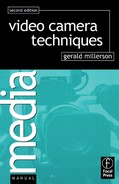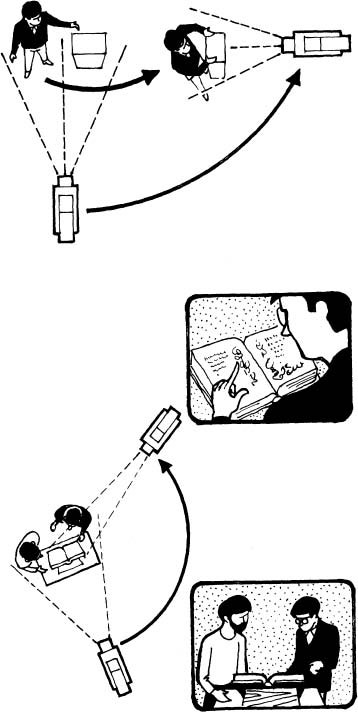Although simple enough in principle, it can take a lot of patient practice to provide smooth accurate lateral and arcing movements to order.
Methods of trucking (crabbing)
As a camera trucks (crabs) across the scene, subjects at different distances appear to pass each other – rapidly in the foreground, and proportionally slower with distance. This parallactic displacement creates a forceful illusion of depth; particularly where the scene contains many vertical features such as posts, columns, or trees.
Trucking alongside a moving subject (a traveling or travel shot) produces a strong impression of speed as background details slide past.
Some dollies are trucked by turning all their wheels sideways (as with the crab or parallel steering mode of a pedestal. Dollies that are steered by one set of wheels only (e.g. camera cranes) are ‘trucked’ by dollying straight across the scene, with the camera head turned sideways.
We usually move the camera round a subject in a tight circle —
• To correct the composition – When one subject is slightly masking (obscuring) another; e.g. in an over-shoulder shot.
• To show the subject from different viewpoints – For example, moving round a statue to show various features. After a knitter has spoken to the camera … it arcs round to watch their hands at work.
Some mountings move more easily than others. Where a tripod dolly or rolling tripod moves too easily, it can be difficult to control smoothly, and may truck quite erratically. Some pedestals are quite hard to push and pull when dollying/tracking, and tiring to truck over any distance. You may need the help of a second operator, to allow you to concentrate on focusing and composing the picture. When trucking with a pedestal at maximum or minimum height, assistance is generally essential.
Larger mountings such as camera cranes need a fair amount of space and time to reposition from a normal in/out tracking line, to truck across the scene. A really tight arc may be impracticable on some types of mounting.
Moving subject
As the person moves to a new position, the camera arcs with him. The speed of the broad arc depends on how fast he moves.
Stationary subject
Here, having listened to the introductory conversation, the camera arcs round to see the subject itself more closely. The speed of this tight arc depends on the pace of the program.

